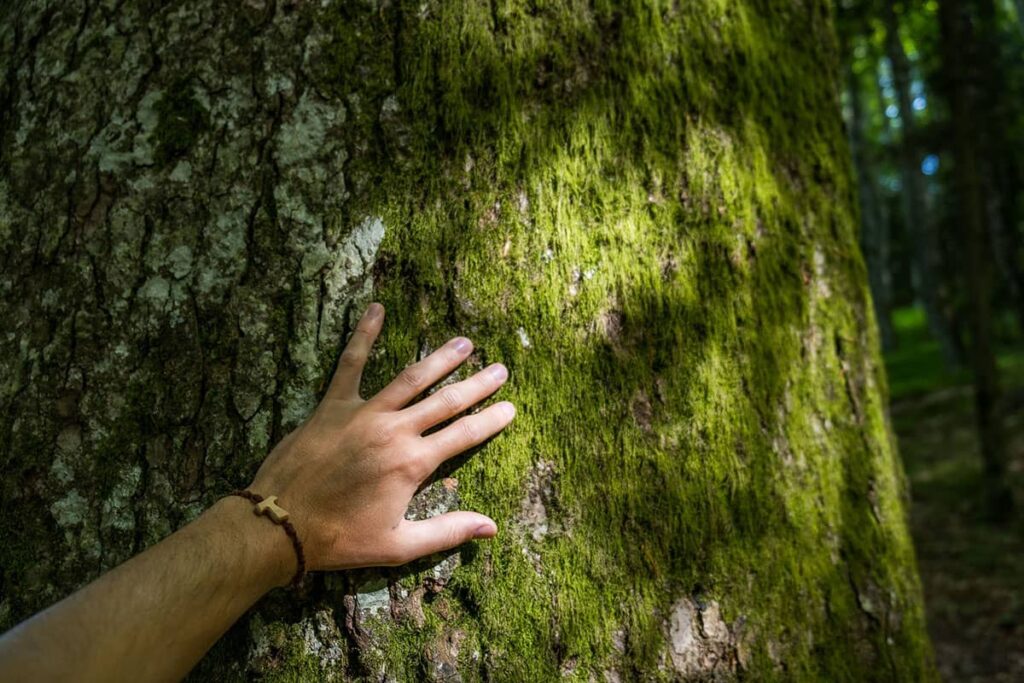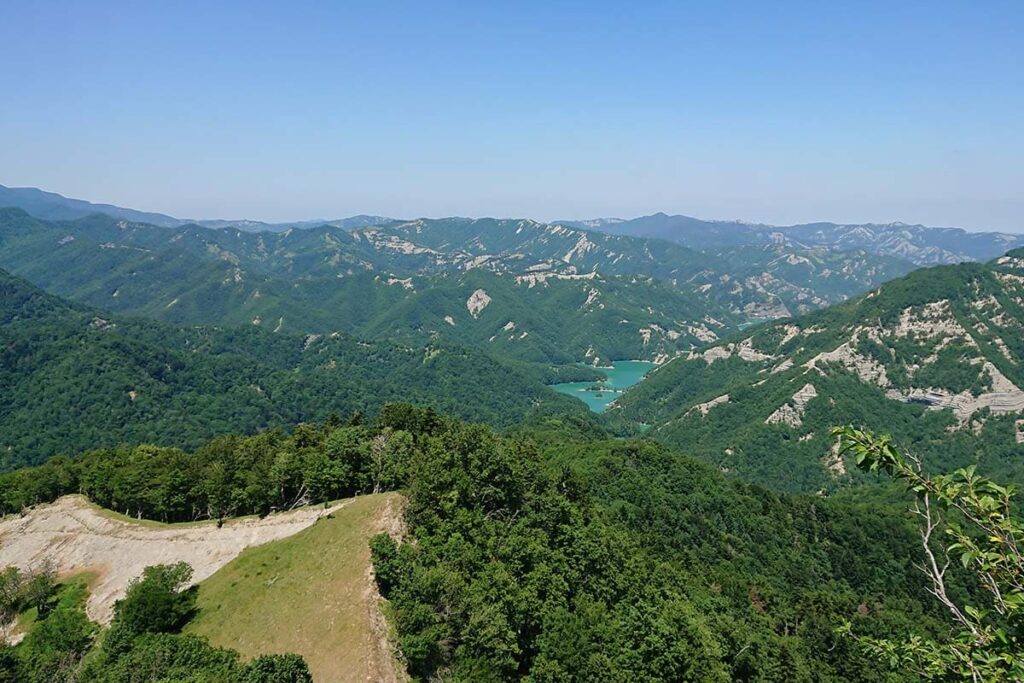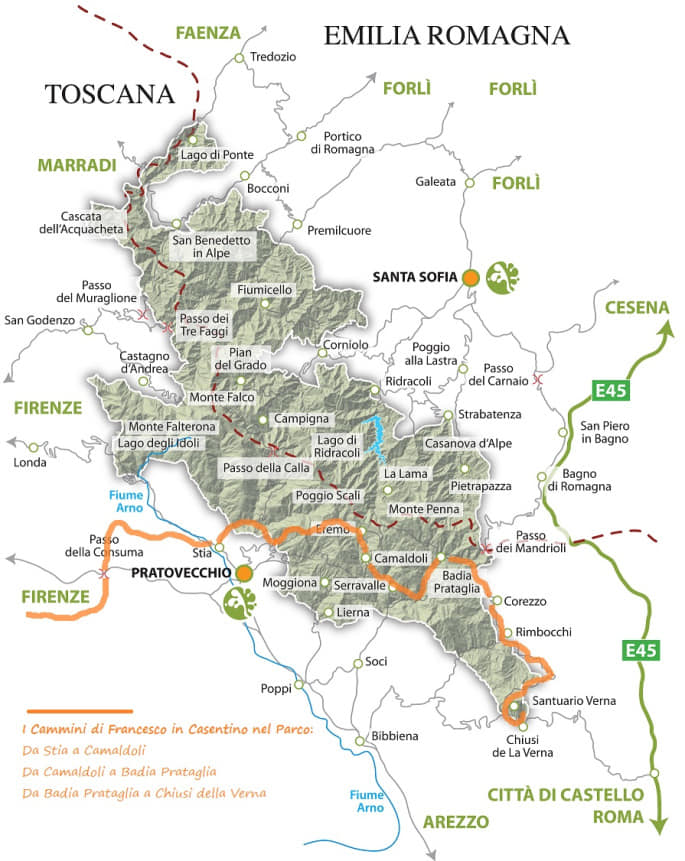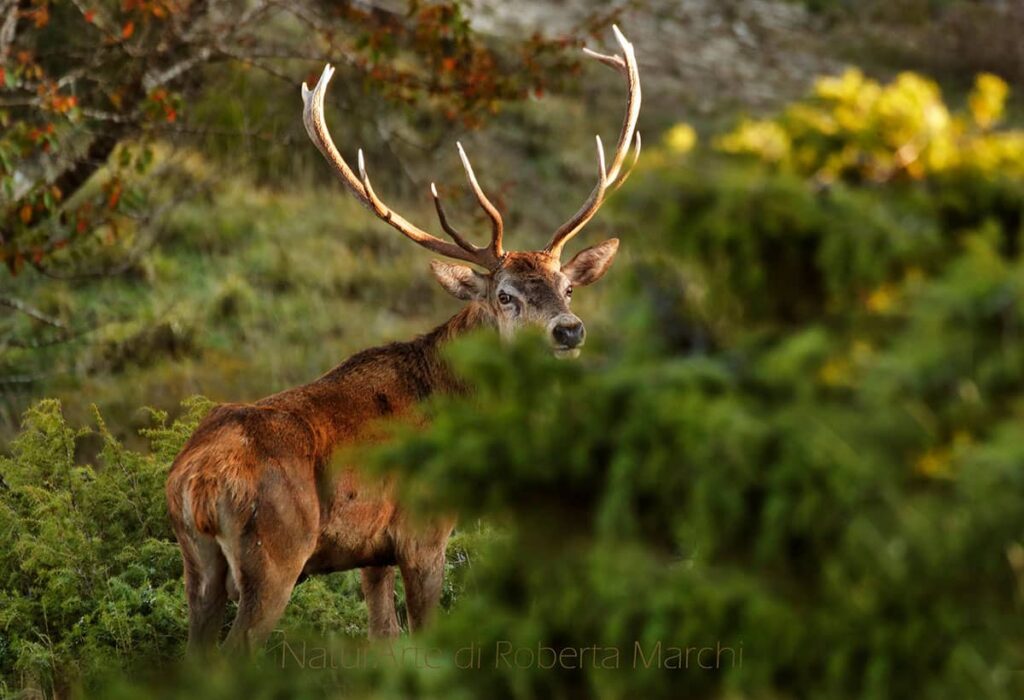This vast park in Tuscany, Italy is a true gem for hikers on the Via di Francesco pilgrimage trail. It boasts stunning ancient woodlands and breathtaking views of mountains and valleys, and monasteries that were beloved by St. Francis.
We'll delve into the park's many important sites and why you won’t want to miss them on your pilgrimage.
Forest Stages
The prestigious national park wraps the top of the Casentino mountains for an area of 36,000 hectares, including the final three Tuscan stages of the Via di Francesco. These stages are unforgettable for their beauty and charm, soaked in the serenity of Mother Nature.

Walking through the national forest is a privilege for pilgrims. Inestimable beauty is hidden in every corner, and often underestimated or hastily passed over.
Pilgrims who walk these stages in this simple way are destined to become ambassadors of nature in the same way St Francis did. It’s up to all of us who cross the park to protect, clean, and advocate for its preservation.
Pilgrim Pledge: We ask that all pilgrims pledge to keep the forest floor free of trash, and to experience it as a sacred place. If you see trash, please pick it up and throw it away at the next town.
Connect with St Francis
St Francis was known for taking long retreats in the wilderness of the national park, including extended cave meditation and prayer. He took several pilgrimages of his own, including walks to Florence, which makes it likely pilgrims walk on some of the same paths walked by St Francis.
St Francis’ legacy is still felt strongly in the region, and the people who live here continue to work tirelessly to preserve and protect the natural and cultural heritage of the park.
As you walk through the park, you will be able to appreciate the ongoing efforts to maintain its beauty and integrity, in line with the values of St Francis.
Forest Stages
Foreste Casentinesi National Park is home to several sacred sites related to St Francis, including the Monastery of Camaldoli, the Sacro Eremo di Camaldoli, and the Monastery of La Verna.
Where to Sleep
Sleeping inside the national park is a true gift. You’ll sleep deep and well in the arms of the forest.
Camping is prohibited inside the park, except at designated campgrounds and rifugios with camping space.
The foresterias at Camaldoli and La Verna are both highly sought accommodations for pilgrims.

The park’s terrain is mainly mountainous, with peaks reaching over 1,600 meters above sea level. The climate is temperate, with cold winters and mild summers, making it a perfect destination for hiking and trekking all year round.
The landscape is dominated by dense forests of beech and fir trees, interspersed with clearings, meadows, and small streams

The forest is also home to several peaks and mountains that you’ll pass by on the trail. These include Poggio Brogli, Poggio della Cesta, and Poggio della Forca, which offer stunning views that are definitely worth capturing with your camera!
The forest’s most famous peak is Monte Falterona, which is north of Stia and not traversed by the Via di Francesco. At over 1,650 meters, Monte Falterona is the highest peak in the park.
The park is also home to several karstic formations, such as caves, sinkholes, and underground rivers, which are a testament to the area’s complex geological history.
The park’s forests are characterized by the presence of beech and fir trees, which create a magical atmosphere that changes with the seasons.
Douglas Fir trees populate the forest from Valagnesi through Camaldoli. The Douglas Fir was heavily planted for reforestation after WWII, and was popular in ancient cultivations in the area.
The Silver Fir is the symbolic tree of Camaldoli, and has religious and commercial links with the monastic order itself. The Camaldolese order cultivates tree nurseries – such as the Vivaio di Cerreta – to illustrate the their belief the forest is a “mass to be molded into a well-defined order”.
Alternatively, St Francis directed his friars to allow the forest to grow naturally without man-made intervention at La Verna.
Chestnut trees are very popular in the forest and larger Casentino region, where many small towns celebrate annual fall chestnut festivals. Fall chestnut gathering is a popular activity for people living near Florence. The most famous tree in the area is the Castagno Miraglia, south of the Camaldoli Monastery.
After Camaldoli, the forest transitions to beech trees.

Among the animal species that can be spotted in the park are the Apennine wolf, the roe deer, the wild boar, and several bird species, including the black woodpecker and the peregrine falcon.
Many Italians hike the park in September and stay at Rifugio Asqua to experience red deer (cervo nobile) bellowing and mating season. Visitors can hear the red deer calling to one another in the evenings.
The park is committed to protecting and preserving its rich biodiversity through several initiatives, including reforestation programs, habitat restoration, and monitoring of wildlife populations.
Photo by Roberta Marchi through Parco Nazionale Foreste Casentinesi
As a responsible pilgrim of the Via di Francesco, you can contribute to the preservation of the park’s natural beauty by choosing eco-friendly accommodations and tour operators and reducing your environmental impact while visiting.
One eco-friendly tour operator is Happy Donkey Tours with Marta Signi, who offer guided hikes through the park with a focus on sustainability and environmental education.
You can also reduce your environmental impact by using a travel bidet and cloth instead of toilet paper, bringing your reusable water bottle, and following the park’s guidelines for responsible tourism. By doing so, you can help ensure that the beauty and biodiversity of the park are preserved for generations to come.
By entering your email, you get the Quick Start emails, free Pilgrim Essentials Kit, and more resources, and agree to our Terms & Conditions and Privacy Policy.

An opportunity for pilgrims, seekers, and adventurers to take an inward journey alongside the spirit of St Francis.

A Toscana, non-religious non-profit to share the discovery and preservation of Franciscan tradition, Nature, and Art.
Disclosure: We may receive affiliate compensation for some of the links on this site if you decide to purchase linked items, helping us to maintain our trails and provide services to our community of pilgrims. Read our affiliate disclosure in our privacy policy.
By entering your email, you get the Quick Start emails, free Pilgrim Essentials Kit, and more resources, and agree to our Terms & Conditions and Privacy Policy.

An opportunity for pilgrims, seekers, and adventurers to take an inward journey alongside the spirit of St Francis.

A Toscana, non-religious non-profit to share the discovery and preservation of Franciscan tradition, Nature, and Art.
Disclosure: We may receive affiliate compensation for some of the links on this site if you decide to purchase linked items, helping us to maintain our trails and provide services to our community of pilgrims. Read our affiliate disclosure in our privacy policy.